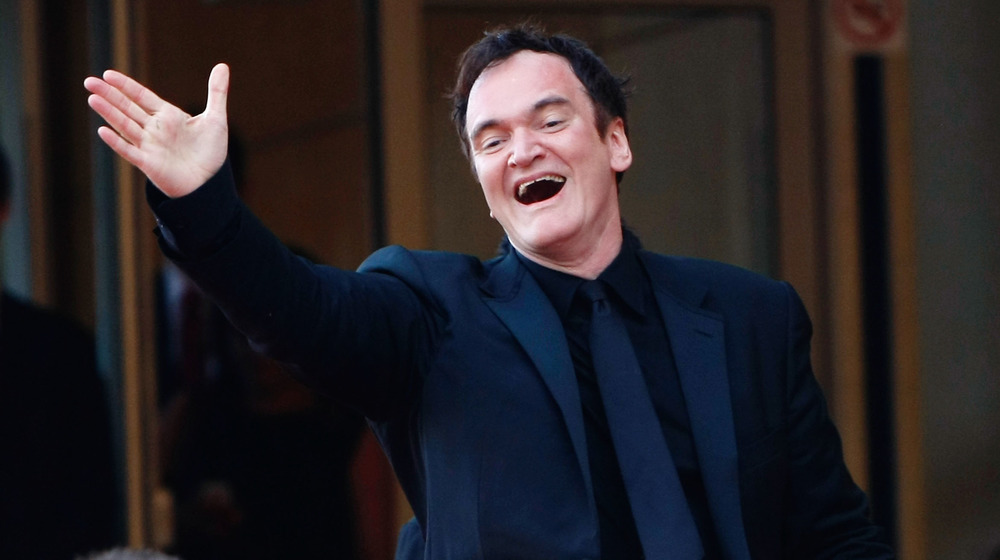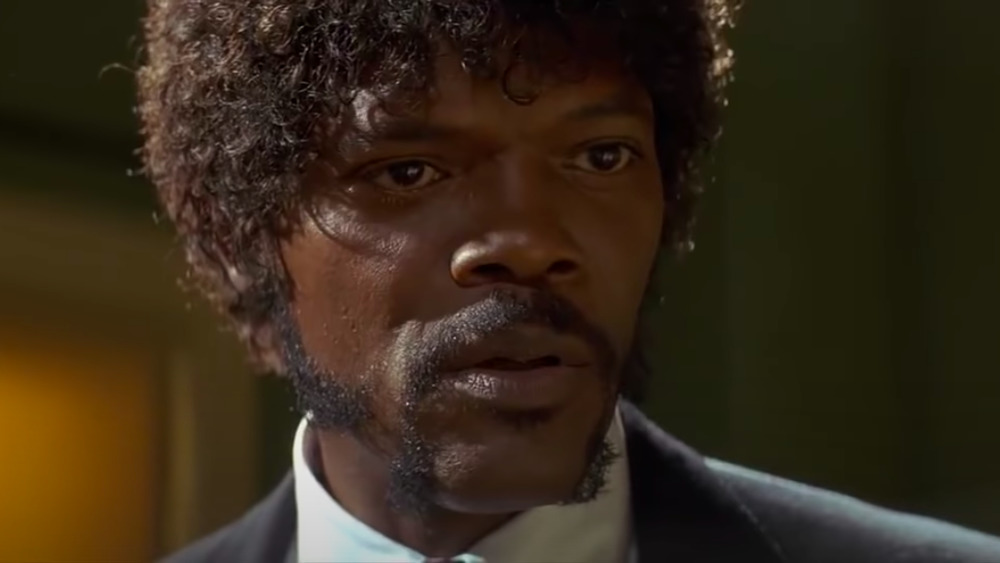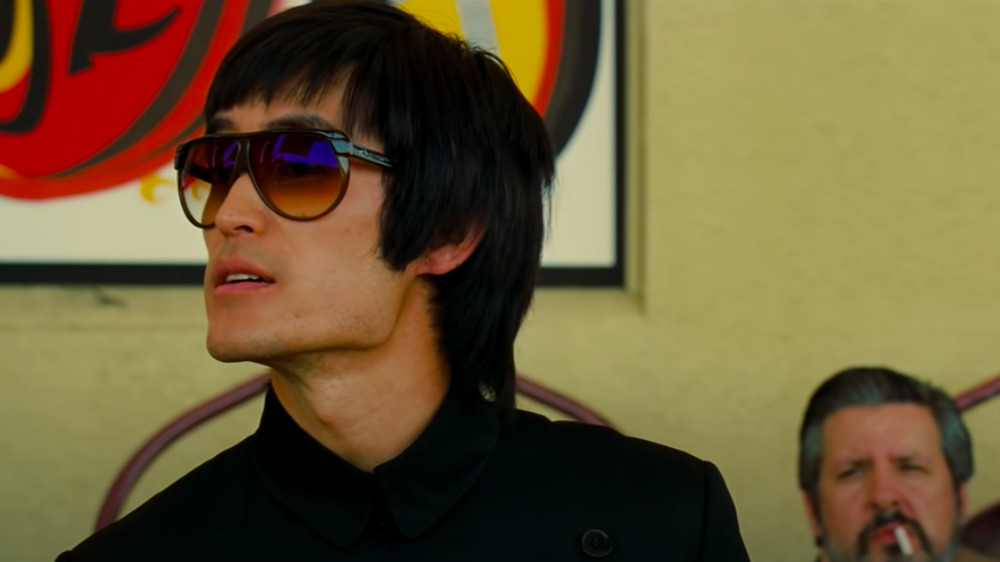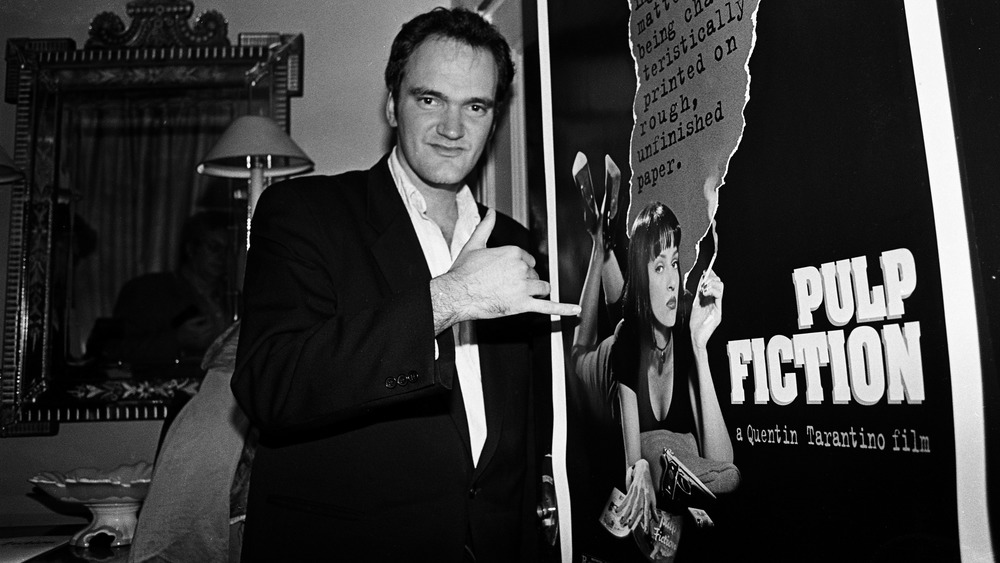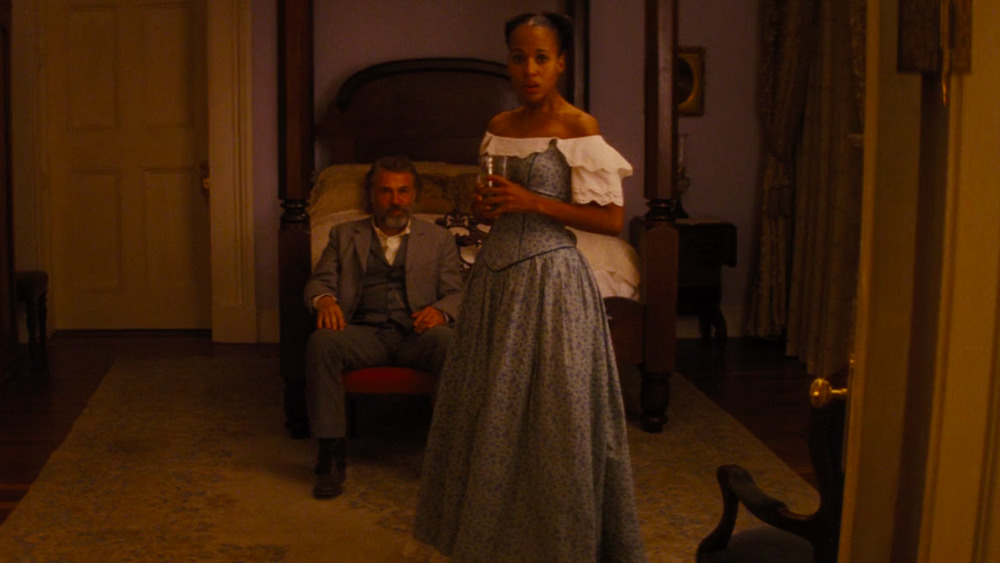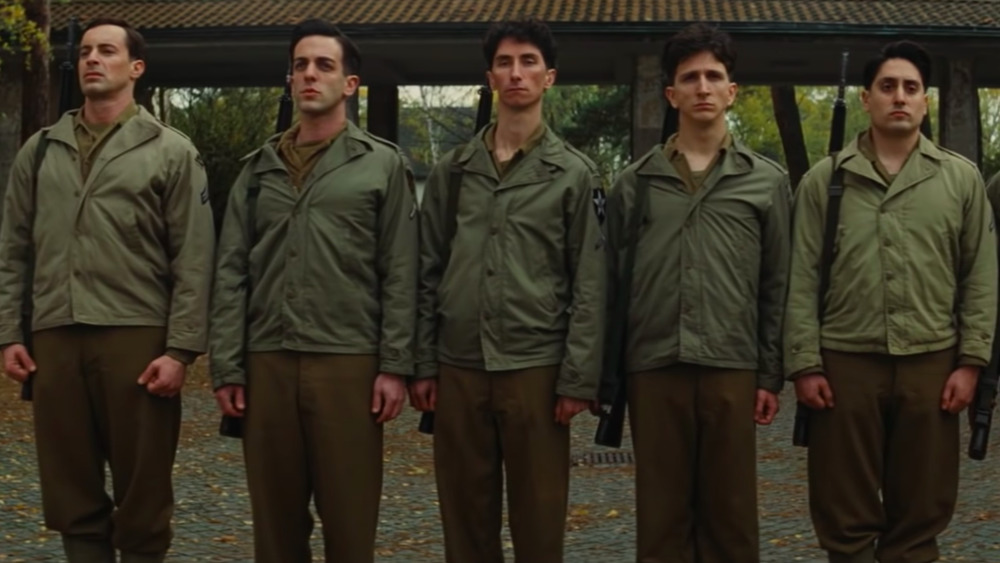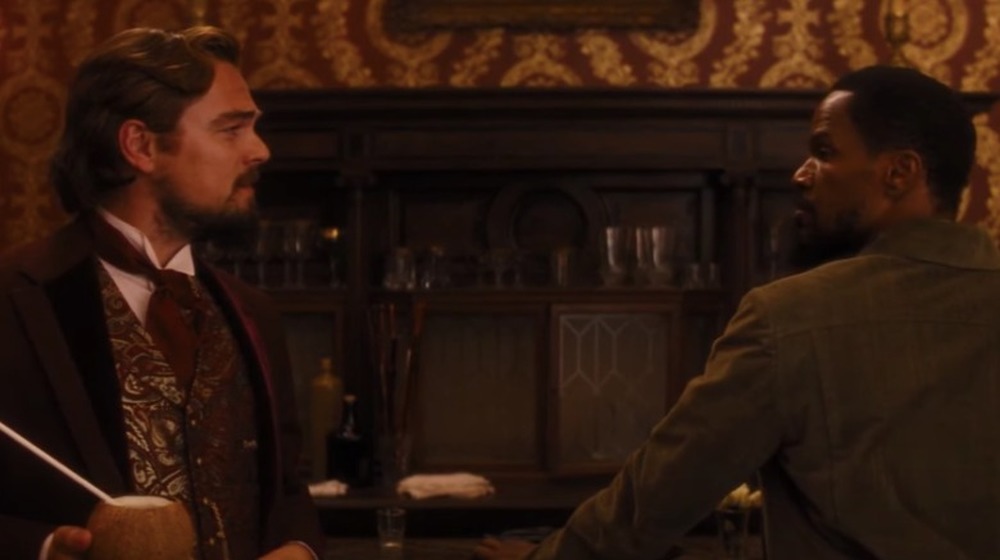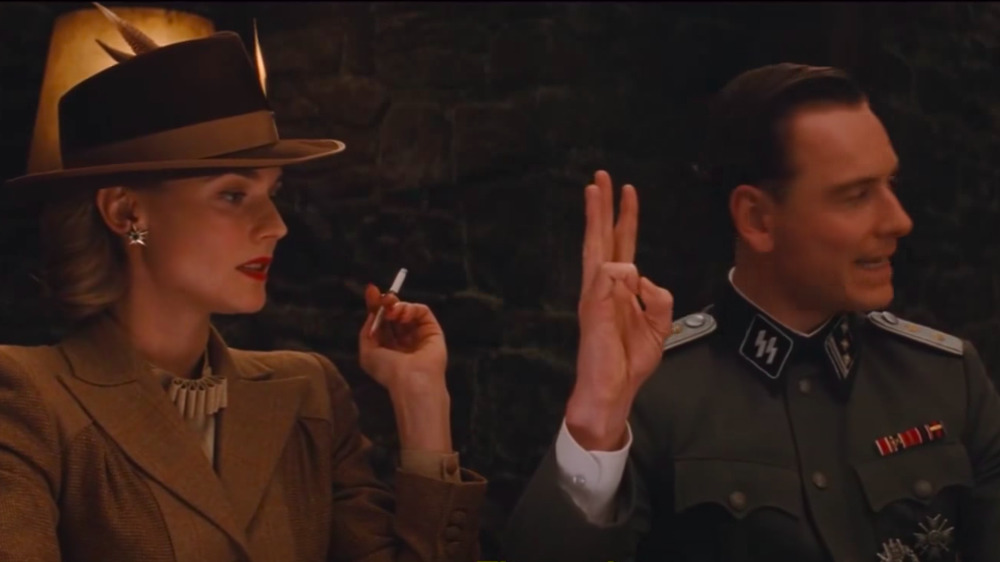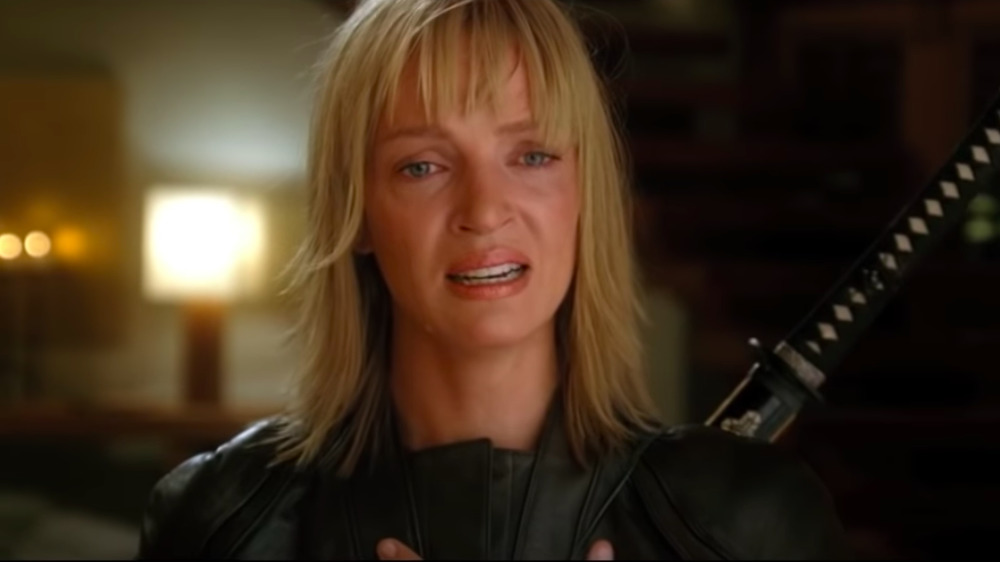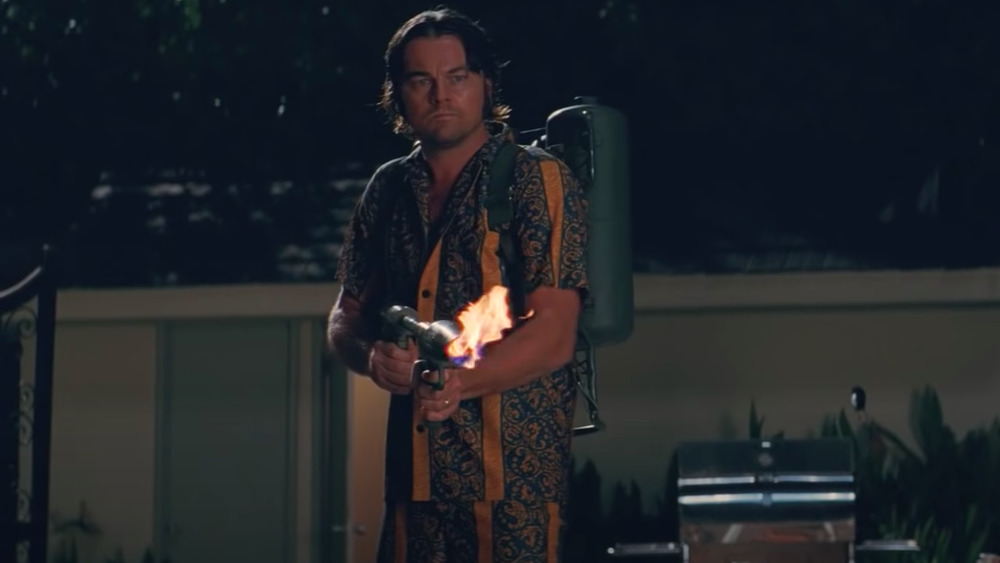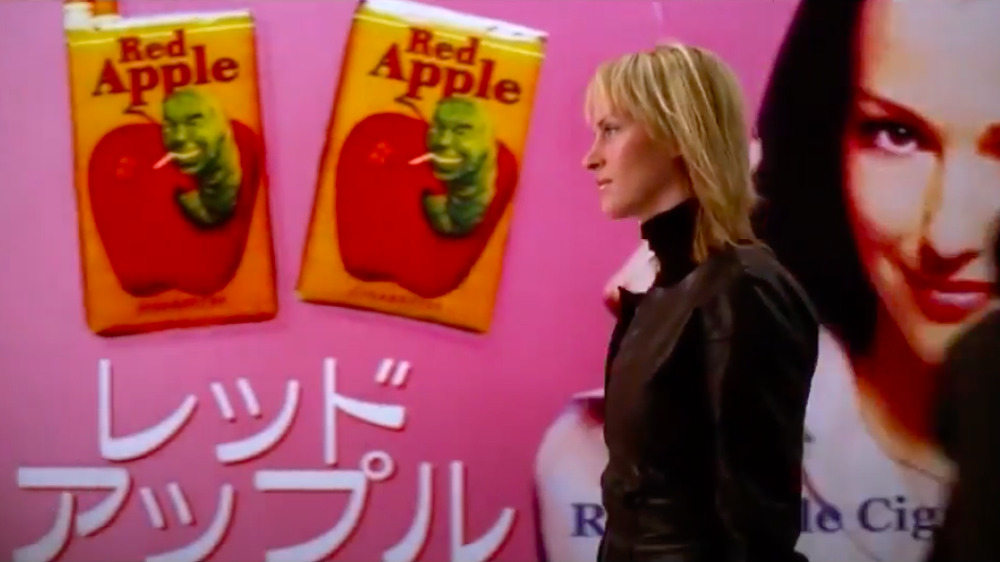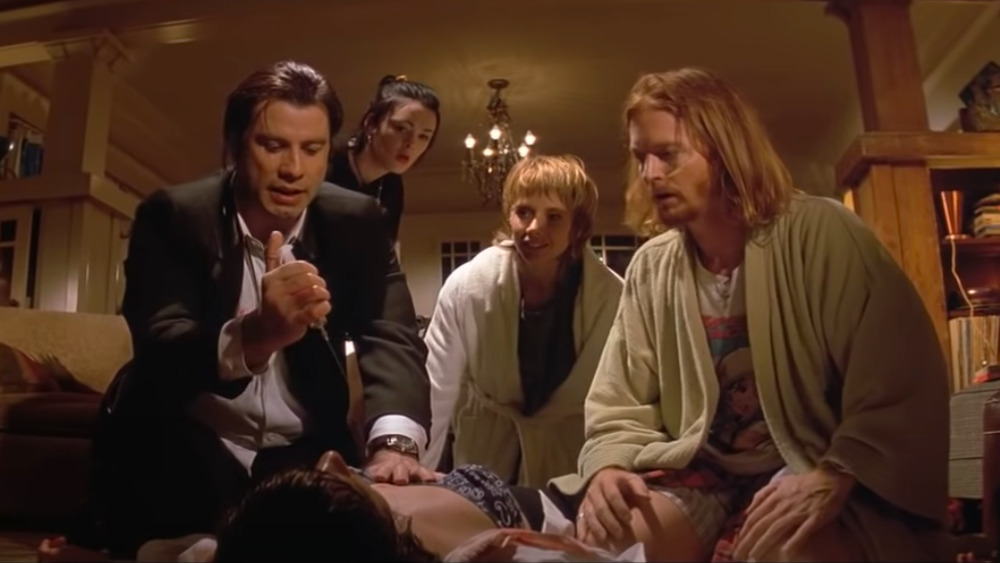False Things You Believe About Quentin Tarantino's Films
Whether you love him or hate him, there's no denying that Quentin Tarantino is one of the most intrepid and prolific directors of our generation. His ballsy approach to filmmaking means his flicks have left a lasting impression on moviegoers — from the abundance of jarring and violent scenes to the unique and witty dialogue that makes his films so, well, Tarantinoesque.
While the Reservoir Dogs director has certainly crafted out his own style, it's evident that he pays homage to other legendary auteurs, be it through subtle nods or blatant, scene-for-scene imitation. "I steal from every single movie ever made," Tarantino once told Empire in 1994 (via Far Out). "I love it — if my work has anything it's that I'm taking this from this and that from that and mixing them together [...] I steal from everything. Great artists steal, they don't do homages."
In some ways, Tarantino is the ultimate movie fan. As he told Positif magazine at the Cannes festival in 1994, "I don't consider myself just as a director, but as a movie man who has the whole treasure of the movies to choose from" (via Scraps from the Loft). Even if you consider yourself the biggest Tarantino buff, it's practically impossible to know everything there is to know about a man who pretty much lives and breathes cinema. Let's take a look at some of the false things you believe about Quentin Tarantino's films.
The Bible verse in Pulp Fiction isn't real
Who can forget one of the most epic moments in Quentin Tarantino's 1994 classic, Pulp Fiction, where Samuel L. Jackson's Jules recites a deadly bible passage. "Ezekiel 25:17. The path of the righteous man is beset on all sides by the inequities of the selfish and the tyranny of evil men," Jackson begins, ultimately finishing with, "You will know my name is the Lord when I lay my vengeance upon thee," before mercilessly killing Frank Whaley's character, Brett. So, was the passage real?
Well, as Tarantino revealed back in '94 to Positif magazine (via Scraps from the Loft), the "quote had a funny origin." As he explained, "I heard it for the first time in a kung-fu film, The Bodyguard [...] Then I located it in the Bible in a slightly different version. I'd also seen a Japanese ninja series on TV called Shadow Warriors." As the director rambles on about the show, the connection finally comes: "At the end of each episode, there was a mortal combat where the chief of the Shadow Warriors, before killing his adversary, would make an interminable speech about the necessity for exterminating evil. The guy who had to listen to this speech was sure to die in the end!"
Speaking with NPR in 2009, Tarantino offered up a much more succinct reason for choosing to plug the reference in the flick: "it's just all very bad a**."
The innacurate portrayal of Bruce Lee in Once Upon a Time in Hollywood
Out of all of Quentin Tarantino's flicks, his ultimate homage to Tinseltown can be found in 2019's, Once Upon a Time in Hollywood. "This film," the director proudly told Esquire, "[is] probably my most personal. I think of it like my memory piece [...] I had L.A. and 1969. This is me. This is the year that formed me. I was six years old then. This is my world. And this is my love letter to L. A."
The flick follows a washed-up television star, played by Leonardo DiCaprio, and his stunt double, played by Brad Pitt, striving for Hollywood's limelight in the late '60s. While they run into personalities conceived from the mind of Tarantino, they also come across characters based on real-life people, such as martial arts legend Bruce Lee (Mike Moh). Tarantino's Lee comes across as brash and egotistic, even taking a jab at boxer Muhammad Ali, whom he claims he could "cripple."
The problem? This portrayal of Lee has been contested as being wildly inaccurate. As Lee's daughter, Shannon Lee, told The Wrap, she found it "disheartening" to see her late father portrayed in such a manner. "He comes across as an arrogant a**hole who was full of hot air," Shannon explained. Dan Inosanto, Bruce's protégé, echoed a similar sentiment, telling Variety, "Bruce Lee would have never said anything derogatory about Muhammad Ali because he worshiped the ground Muhammad Ali walked on."
Quentin Tarantino wasn't the only writer behind Pulp Fiction
Many Quentin Tarantino fans consider Pulp Fiction one of his finest pieces of cinema. From the moment Dick Dale's version of "Misirlou" rips through the opening credits and you see the words, "A film by Quentin Tarantino," flash across the screen, you know you're in for a wild ride. That being said, however, should the prolific director wholly take credit for the flick?
According to Vanity Fair, Tarantino was hit with the idea for Pulp Fiction while working at Video Archives, a "suburban-L.A. store," in Hollywood. As the outlet writes, "he was a nobody." Watching movies day in and day out, he decided to collaborate on the writing process with co-worker Roger Avary, a friend of his. "Tarantino would write the first story, about the guy who takes out the crime boss's wife. Avary's section centered on the over-the-hill boxer, who double-crosses a crime boss," Vanity Fair explains. As NickyTyrone.com notes, they "co-wrote Pulp Fiction," and ultimately, "both received screenwriting Oscars," yet never worked together again after that.
Before the movie came out, "Avary reportedly received a call from Tarantino's attorney, demanding that he accept a 'story by' instead of a co-writer credit, so that Tarantino could say, 'Written and directed by Quentin Tarantino.'" An allegedly hurt Avary eventually gave in, ultimately telling Vanity Fair in 2013 that he's "at peace with his collaborator and his credit," revealing, "I love the movie. I'm delighted with my contribution. That is enough."
Quentin Tarantino doesn't showcase the strength of enslaved women in Django Unchained
Django Unchained saw Quentin Tarantino tackle another period piece after 2009's Inglourious Basterds, this time using the backdrop of the Old West coupled with themes of racism and slavery. As The New York Times wrote of the flick, "Django Unchained is unabashedly and self-consciously pulpy, with camera moves and musical cues that evoke [...] the cornfed westerns of the 1950s."
Smithsonian Magazine noted that "aspects of the film [...] successfully illuminate the dark corner of the enslavement of African Americans," adding that Tarantino correctly depicts the reality of slavery in pre-Civil War America. While he gets some things accurate, such as scenes "where Broomhilda is viciously whipped or where Django removes his shirt to reveal a lifetime of scars," the magazine notes that one of the "the biggest disappointments is the depiction of enslaved women," who are shown as "either sexual partners or cowering individuals waiting to be rescued."
In reality, these women "found ways to maintain a sense of family and a belief in the possibilities of future," with one example being Harriet Tubman — one of the most notable activists of the time. "During slavery, many women struggled to define and to defend themselves in circumstances that sought to strip them of their humanity," or in Tubman's case, leading hundreds of slaves to freedom through the Underground Railroad. While the movie shows men persevering, it doesn't do much for their female counterparts.
The Basterds from Inglourious Basterds did exist... but not how you're led to believe
After watching 2009's Inglourious Basterds, you may wonder if the Nazi-hunting group of "Basterds" truly existed during the Second World War. While characters such as Eli Roth's Sgt. Donny Donowitz (aka The Bear Jew) pummelling Nazis to death with a baseball bat definitely made for unsettling cinema; were they real?
Surprisingly enough, this group of men truly lived, yet Tarantino embellished the truth quite a bit. Brad Pitt's character of Lt. Aldo Raine tells his troops to deliver him "100 Nazi scalps," but as real-life veteran Colin Anson told the Independent, "It wasn't all violent gore and stabbing people and scalping them – certainly not," adding, "I don't know how to scalp somebody."
As Kim Masters, daughter of a Jewish-American soldier, revealed to NPR, the real soldiers that Winston Churchill dubbed the "X Troop," were "part of a secret unit that took down leaders of the Third Reich." Per the Independent, the "German-speaking Jewish refugees" that made up the collective were "motivated by a hatred of Nazism and were sent on secret missions, often behind enemy lines." The similarities pretty much end there, and as Max Dickson, one former member of the X Troop reveals, he was "unimpressed" by Tarantino's depiction, saying, "I wouldn't like to glorify anything that has to do with killing, and that's what it always ends up with."
Mandingo fighting from Django Unchained most likely never happened
2012's Django Unchained was celebrated for its ability to re-write the history of pre-Civil War America, doing "to slave owners what Inglourious Basterds did to Nazis" (via The Hollywood Reporter). As the outlet explains, the revenge flick "makes a point of pushing the savagery of slavery to the forefront but does so in a way that rather amazingly dovetails with the heightened historical, stylistic and comic sensibilities at play."
One plot point in Django Unchained raised eyebrows and shocked viewers, however, leaving many wondering if it was, in fact, historically accurate. In one scene, Django and Dr. King Schultz (played by Jamie Foxx and Christoph Waltz, respectively) come across "two (Black) slaves," who are fighting "in a bare-knuckle death match, for no reason other than the (white) slaveowners' enjoyment," per Huffington Post. This "sport" was allegedly called "Mandingo fighting," yet, according to "a bevy of historians [...] it probably never happened."
As David Blight, the director of Yale's center for the study of slavery explained to Slate, the main reason behind slave owners not "pitting their slaves against each other" boils down to strict economics: "Slavery was built upon money, and the fortune to be made for owners was in buying, selling, and working them, not in sending them out to fight at the risk of death." As the outlet adds, "no slavery historian we spoke with had ever come across anything that closely resembled this human version of cock fighting."
Did the three-finger drink order give the Basterds away?
Quentin Tarantino's attention to detail is practically unparalleled in Hollywood. "He really doesn't let anything past [him]," explained actress Diane Kruger to Film 4. One prime example? The anxiety-inducing pub scene in Inglorious Basterds. Long story short, Michael Fassbender plays the British Lt. Hicox, who goes undercover as a Nazi meeting Kruger's character, double agent, Bridget von Hammersmark. Upon arriving, he's greeted by a gaggle of German soldiers, along with main antagonist Major Hellstrom, played by August Diehl.
Hicox eventually blows his cover, resulting in total carnage. Tarantino leads you to believe this is a result of the Brit's drink order, which sees Hicox ordering three glasses of scotch while raising his index, middle, and ring fingers — different from the German way of ordering, which sees one raising their thumb, index, and middle fingers. As Reddit user Death_Star_5 explains, however, it's most likely a red herring due to a variety of different hints Tarantino gives — even pointing out that "Hellstrom never actually says that this is what gave them away. It was only Bridget von Hammersmark who suggested it."
One language expert further explained other clues while speaking to YouTuber Jack Howard. "Yeah, you can definitely hear some artifacts of English pronunciation when he's speaking [...] It makes it less surprising that [Hellstrom] does figure it out because [...] I'm not even a native German speaker and I can hear them [so] this accent-fiend can hear them as well."
Kill Bill Vol. 2 isn't actually that violent
The release of 2003's Kill Bill: Volume 1 was met with widespread acclaim, snatching up numerous awards and even gaining the praise of legendary film critic Roger Ebert himself, who gushed, "The movie is not about anything at all except the skill and humor of its making. It's kind of brilliant."
That being said, it also received a fair share of criticism, too, mainly due to the flick's generous amount of violence on display. As BBC News notes, "It is also his most violent film to date, according to early reviews, with lengthy samurai sword fights and a high body count." Tarantino defended his film, explaining, "it was so outlandish and bloody that it was obviously set in 'fantasy land.”'
Once Kill Bill: Volume 2 came out the following year, the complaints were the same. VOA wrote that the movie "does not stint on the killings and visceral fight scenes," yet that being said, is it even true? As IFC points out, "Kill Bill Vol. 2 was not as violent as you might think," adding, "Only three people are killed onscreen in the entire second movie." The flick's criticisms even resulted in a massive eye roll from Kill Bill's biggest star, Uma Thurman, who declared, "I [...] hate what I consider this weird American phenomenon of having such tolerance for real life violence and making such a big fuss over creative expressions of violence. It's astounding to me" (via VOA).
Quentin Tarantino re-wrote Manson Family history
Every true crime fan knows the basics of the infamous Manson Family murders of the late '60s. Per ABC News, "In the early morning hours of August 9, 1969, actress Sharon Tate, who was 8 1/2 months pregnant, and four others [...] were brutally murdered at the Beverly Hills home of Tate and her husband, director Roman Polanski." Charles Manson led the killings, yet the cult leader didn't actually commit any murders himself. Thankfully, he was locked up in jail, where he eventually died in 2017.
Quentin Tarantino's 2019 star-studded hit, Once Upon a Time in Hollywood, saw many of the key players involved in that fateful night, yet the director took some artistic liberties and rewrote history — a lot. Anybody well-versed in the Manson murders knows that the ending — which sees Tate (played by Margot Robbie) and her friends all surviving — is pure fiction. But what about the film's main two characters: washed-up TV star Rick Dalton and his stunt double, Cliff Booth (played by Leonardo DiCaprio and Brad Pitt, respectively)?
As Vox reveals, the duo are fictional characters who "bump into a lot of people who really existed." In fact, Tarantino even places Dalton as Tate and Polanski's next-door neighbor on Cielo Drive — the actual street where the murders were committed. Per Rolling Stone, "it's not all that surprising" that Tarantino chose this route, given his penchant for "revisiting historical atrocities and making sure the good guys win."
Quentin Tarantino uses his own, made-up brands in movies
If you're a big fan of Quentin Tarantino's vast body of work, your eagle eyes may spot two brands that repeatedly appear in many of the director's flicks: the Hawaiian fast-food chain, Big Kahuna Burger, and the very-specific brand of smokes, Red Apple Cigarettes. The latter has subtly appeared in various Tarantino movies, finally taking center stage in a cigarette commercial in Once Upon a Time in Hollywood. The same goes for the beloved Big Kahuna Burger, which makes its most prominent appearance in Pulp Fiction.
While some fans think Tarantino creates his own brands due to his hate of product placement — that's not the case. As the director explained in The Greatest Movie Ever Sold, "I haven't done that much product placement in my movies because for the most part, I've actually been usually refused."
Although Tarantino has been declined product placement in his flicks, the director knows when to give back. Who remembers spotting the iconic yellow Chevrolet Silverado SS truck from Kill Bill in Lady Gaga's 2010 music video for "Telephone"? "His direct involvement in the video came from him lending me the Pussy Wagon," Gaga told E! that year. "We were having lunch one day in Los Angeles and I was telling him about my concept for the video and he loved it so much he said, 'You gotta use the Pussy Wagon.'"
The adrenaline shot scene from Pulp Fiction was actually filmed in reverse
Quentin Tarantino doesn't shy away from violence and making his viewers squirm. Who can ever listen to Stealers Wheel's "Stuck in the Middle with You" without the gristly mental image of Mr. Blonde (played by Michael Madsen) in 1992's Reservoir Dogs, brutally torturing a policeman?
Another memorable yet macabre scene is in Pulp Fiction, where John Travolta's Vincent Vega is required to give Uma Thurman's Mia Wallace a shot of adrenaline directly into her chest after she suffers a heroin overdose. "When you watch it, the audience is broken into thirds," Tarantino explained in Quentin Tarantino – The Man, The Myths and the Movies. "A third is diving under their chair, a third is laughing, and the other third is doing both at the same time." The squirm factor comes from the obvious question: did Travolta actually plunge a needle into Thurman's chest?
Of course not! As it turned out, the actress "had a fake chest-piece strapped to the front of her body, and the shot was reversed so that the needle was actually pulled out." As one Tarantino author, Jason Bailey, told the New York Post, "It's one of those great, almost Hitchcock-in-Psycho things. It's cut so close, you never see the impact, but you see right up to it, and you hear the sound effects and you connect the dots in your head."
